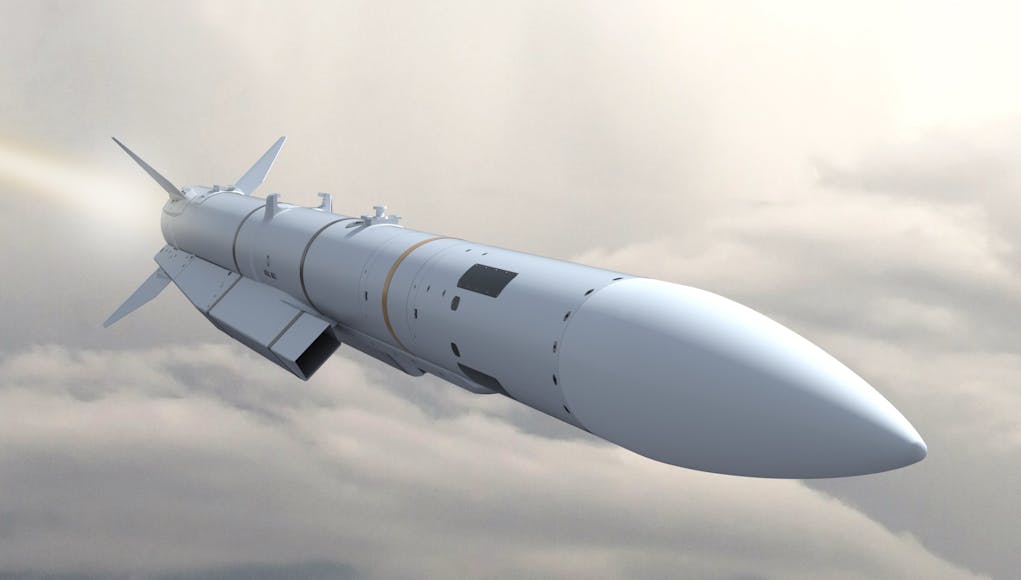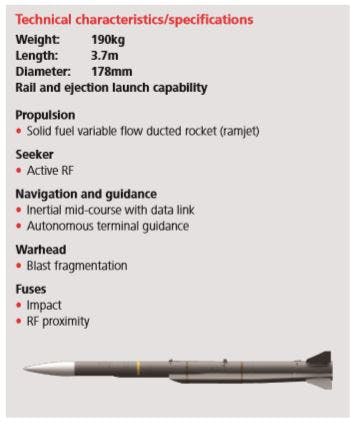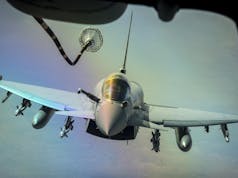Meteor is a ‘Beyond Visual Range Air-to-Air Missile’ system developed by MBDA.
The Meteor programme sees the UK, France, Germany, Italy, Spain and Sweden working together to provide access to technology and expertise across those nations.
The missile is guided by an advanced active radar seeker and is also equipped with two way data link communication, enabling the launch aircraft to provide mid-course target updates or retargeting if required, including data from third parties.
According to Saab:
“An active radar target seeker combined with an RF proximity fuze, both of which are highly resistant to both active and passive countermeasures, ensures reliable detection, tracking and discrimination of the target.”
Meteor, say MBDA, offers a multi-shot capability against long range manoeuvring targets, jets, UAVs and cruise missiles in a heavy electronic countermeasures environment with range well in excess of 150 kilometres, MBDA also say that the no-escape zone of over 60 km is largest among air-to-air missiles.
A two way data-link and an active radar target seeker ensures that Meteor reaches its target, even at very long ranges. A jamming resistant proximity fuze and a lethal high explosive blast-fragmentation warhead combine to give the missile its high kill probability.
The missile is often lauded for its outstanding kinematic performance and according to MBDA, Meteor’s performance is achieved through its unique ramjet propulsion system – solid fuel, variable flow, ducted rocket.
“This ‘ramjet’ motor provides the missile with thrust all the way to target intercept, providing the largest No-Escape Zone of any air-to-air missile. To ensure total target destruction, the missile is equipped with both impact and proximity fuses and a fragmentation warhead that detonates on impact or at the optimum point of intercept to maximise lethality.”
According to MBDA, Meteor has three to six times the kinetic performance of current air-air missiles of its type.















As I mentioned in an earlier post, time to replace AMRAAM with a new and clearly better version from MBDA.
Added information on the future update to Meteor.
https://thediplomat.com/2017/11/uk-japan-push-ahead-with-joint-air-to-air-missile-project/
Does it even fit inside an F-35B?
Yes, it is having redesigned tail fins (shorter but longer) so that they can fit in the weapon bay of a F35B. MBDA have said there’s no performance difference. So the modification will be used on all Meteors regardless of aircraft fit.
“redesigned tail fins (shorter but longer)“
Shorter but longer? I’m trying to work out what you’re describing there.
“shorter but wider” might be better?
That’s what I was wondering but in that case is it just the fins affected or is it more? Has the whole missile been shortened and the corresponding loss of tail fin area been compensated for by making the fins wider? Presumably the issue is that the current Meteor breaches either total length or maximum diameter constraints of the internal bay so if it it a length issue then I don’t see how shortening just the fins helps unless that shortening allows the missile body itself to get shorter as well.
Conversely though, if it is an overall-diameter constraint that is currently being violated then I can see how making the fins project less from the casing (thus reducing the overall diameter) and compensating for lost surface area by lengthening the fins (having them run further up the body towards the nose) would be just a fin adjustment, no change to the core body of the missile, to reduce the maximum diameter.
It’s just the fins. They are longer in length and shorter in width for the F-35B.
But this is not a special or separate version. The rest of the missile is exactly the same, the fins are the only change. The fins are actually installed by the armourers prior to loading the missiles. It may be that all Meteor’s are delivered from MBDA to the UK with 2 sets of fins depending on which aircraft they are fitted on.
Meaning shorter in wingspan perhaps?
Correct. The additional length is to provide the additional lift and control authority that the ‘clipping’ of the wings loses. But thats the only changes necessary.
What isn’t clear though is if the Meteor will be compatible with the proposed ‘six-shooter’ rack proposed by LM for Amraam to enable 6 Amraam to be carried internally. The fact that it’s not proposed by Raytheon could mean it has the possibility of carrying 6 Meteor as well…might be a bit of a long shot though for the B variants with their shorter bays, so I suspect of no use to the UK.
This is what was posted on this site in April 2017: “MBDA is planning integration of Meteor on the Lockheed Martin F-35 Lightning II Block 4. The Meteor has already been checked for fit in the internal weapons bays of the jet and is compatible with the aircraft’s internal air-to-ground stations, but would require modification of the fin span and air intakes to be compatible with the air-to-air stations.”
You know what he means or at least a 50/50 chance
LOL. Yes, I was covering both bases, although Rudeboy’s use of the term “wingspan” has now made it 100% clear which of my guesses was correct. Thanks Rudeboy.
Oh, sorry 4thwatch, it was you who introduced the term “wingspan”. Thanks to both you and Rudeboy for clarifying the situation so well.
What does “No Escape Zone” actually mean ? Do they mean it has a 100% hit rate at any target within 60km ? That feels like a pretty big claim.
Hi. It means even at the very extremes of the missiles range, it still has enough energy to out manoeuvre the most agile of aircraft. ?
Thanks. Makes more sense
It means the enemy aircraft cannot turn around and try to out run the missile before it runs out of fuel. If the range is 100km and the target 90km it still has a good chance of turning around and making it outside the 100km kill zone before the missile has caught it.
Thanks. Makes more sense
This is a good and easily accessible description.
https://www.youtube.com/watch?v=K8ucoQMAbnA
Thanks for the link
Meteor has a very long and interesting history going all the way back to Sky Flash which of course was based on the US Sparrow.
I wonder if an air to ground version is feasible? Ditch the radar & add an off the shelf IIR seeker + GPS. For those small mobile targets that may only appear briefly before vanishing again. You need something with a very short flight time, that can get there quickly before the target moves off.
I’ve also thought that would be a great idea, maybe a layered air defence with a ground launched meteor and camm (sky sabre) similar to s400 and iron dome with multiple missles for different ranges
It would be very expensive…outside of an S-400 TEL there is little that would be worth the shot, particularly given the small warhead that could be carried. IIR wouldn’t be much use at range either, MMW would be used.
However…MBDA did have a green painted Meteor on the Land Precision Indirect Fires proposal along with CAMM/Brimstone hybrids. Think they were just floating an idea as LRPF would be far cheaper and more useful as a high speed strike capability.
The RAF and MBDA did talk about using Meteor as a high speed, long range ARM. Presumably this was in the future taking advantage of the AESA version being developed with Japan.
But for ground targets that appear and then move Spear with its range and search capabilities is a better fit. For a faster missile the CAMM/Brimstone hybrid would make the most sense.
An air to ground Meteor would not be for ordinary targets, but for high value, mobile, brief window targets i.e. Chief dictator/warlord/terrorist boss or mobile ballistic missile. Or targets of equal value that are time limited.
MBDA seem to have developed some very capable missiles in brimstone, CAMM’s and Meteor!
Surely this could be a replacement for Astor and a mixed system would not only benefit the army (I know the army doesn’t use Astor, but only has short range air defences) but also the navy, if both could use the mark41 launcher on Royal Navy ships!
I see they are working on spear 3 the third version of brimstone with a 80mile range which I think is doubled the original missiles range and an EW version!
It does seem to me that taking these capable systems and developing them to meet crucial tactical needs is a must!
IMO the helio launched version of brimstone on apache and wildecat would make sense with us using it on the typhoons and Lightings! Keeping a commonality of system must be more cost effective and it is a proven system!
Developing these successful systems for other tasks seems a cost effective solution in current times of such expensive systems, making them multi platform and even multi use, of course in that I dont mean the same missile for the different tasks but a variation of that missile, different warhead/seeker for example!
Just a thought or a few thoughts
Manufacturers love to hype up the capabilities of a new missile. They all do that. The missile isn’t anything till it performs in real combat. Simple.
I don’t think there is any commonality between Meteor and Astor 30. If Meteor was ground launched then on paper it would out perform Astor 30. Could it be a future candidate for Naval/ground based air defence? Or are there reasons it would not be possible?
It would need a redesign for a booster to get it off the ground and up to speed for the ramjet to start working. When air launched its already in the air and has got the aircraft’s speed already working for it.
Yes that makes sense. From what I have read it already has a booster to take it up to a speed where the ramjet can take over. The air intakes stay closed during that phase. This is only from what I have read on Wikipedia mind. Seems like an opportunity to create a long range CAMM style family. Maybe its not possible or just not economical.
MBDA are looking at it as an interceptor for MARV’s in BMD systems.
But add in a decent booster and a ‘pif-paf’ system and for most engagements it would outperform Aster-30.
That is interesting, cheers.
Both the Aster and Meteor have pros and cons for surface to air missiles. One is range and the other is height. If we look as the Astor, the engine is a dry mix chemical that is burnt in a rocket engine. Once the fuel is used up, the missile is effectively flying on inertia where gravity, air resistance and drag start degrading its velocity. Conversely, the Meteor uses a “throttable” ram jet engine. A small rocket booster accelerates it to around Mach 1.5 where the ram jet can start operating. Once the ram jet is operating the Meteor accelerates to Mach 4. For a target that is flying straight and level at say 5000ft around 100km from you, both missiles will use a ballistic path to fly above the target and with the help of gravity to drop on to the target. This flight path allows the missile to have a longer more efficient range, but also means that it has more kinetic energy to manoeuvre on to the target when it starts to fly erratically.
This is where the endgame differences come into play. At maximum range the Aster will be slowing down quite dramatically as its relying on a combination of inertia and kinetic energy to fly towards the target. Its true that Aster has lateral piff-paff motors that push the missile towards the target. But there’s only so much fuel reserved for these and it will quickly be used up. Whether this is adequate for a highly erratic target has yet to be real world tested. The Meteor does things differently. One the missile reaches the top point of the parabola, the missile can turn off the motor and glide towards the target. Once it gets within a certain distance the missile reactivates the motor reaccelerating then manoeuvres towards the target. Therefore, the Meteor manoeuvres towards the target under power, which significantly increases its chances of a hit.
The Meteor’s ram jet is therefore better for attacking targets below 70,000ft where there’s sufficient oxygen for the engine. However, for targets above this height a rocket is best method.
The piff-paff of the Aster makes it more terminally manoeuvrable but only for a limited amount of time, owing to fuel constraints as per above. I’ve not recently looked what G each can pull as a quantitative comparison though.
And again as per above, the suitable altitude of regime of the two missiles differs owing to the rocket of the Aster and the ramjet of the Meteor. If the BMD profile requires exo-atmospheric intercept, only Aster is suitable for this; to that end I’ve not seen research for the Meteor in a BMD role.
Meteor is 1 metre shorter than Aster30, so potentially room for a 1 metre booster and it still able to fit in a VLS. Obviously cost is an issue, but this could give a Sea Viper or SAMP/T a potential mix of Aster30 NT / b2 in the BMD role and boosted Meteor taking on air breathing threats at 250+ km.
Yes, I agree due to the Meteor’s ram-jet engine’s requirement for oxygen, its BMD would be limited to around 75,000ft. Pretty certain MBDA know the maximum altitude of Meteor and they would have classed it as secret, so we can only surmise its maximum altitude. Regardless, due to its need to breathe oxygen, the Meteor would have a very limited use for BMD.
If we could combine Aster’s rocket engine with Meteor’s ram-jet, we would have the best of both worlds. The combined use of the two engines would make it very efficient. Allowing the missile to use its ram-jet in the denser air and then switching on the rocket in less dense air to go exo-atmospheric. This would allow the missile to cover both an increased range and height. For a conventional aircraft style target or cruise missile, by using both engines would significantly increase its speed in to the hypersonic regime. Thereby allowing the missile a fantastic reaction time. Hmm, perhaps, we should contact MBDA?
I’d never thought of staging it that way round. It would give longer range and BMD performance in one missile instead of the variants I suggested. Good work, get MBDA on the phone!
Hybrid rocket/ramjet? Sounds like RE’s SABRE engine.
Thanks for the information. That was a very interesting answer. Outside of Ballistic missile defence Meteor seems to be the more capable missile.
It remains to be seen how effective the piff-paff motors are after multiple uses. Theoretically, The Aster should have a better chance of a kill or doing damage as it closes with the target. This primarily due to the piff-paff motors throwing the missile towards the target. However, I suppose it all depends on the range to the target. At maximum range the Aster will be slowing down quite considerably, whilst the Meteor can nearly maintain its maximum speed.
It is a complete BS – the no-escape zone is much more, than 60km. It is ca DOUBLE of that!!!